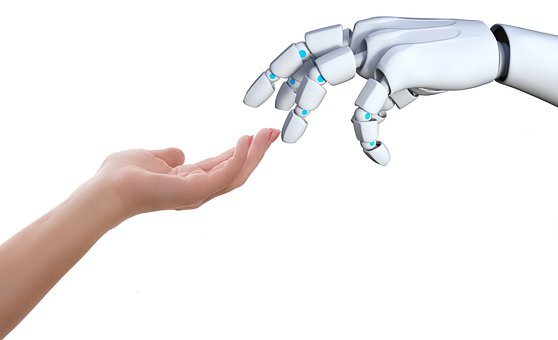A Brief History of Cobots
Before cobots, there were industrial robots. These industrial robots were invented in the 1950s and developed by George Devol, an American inventor.

Collaborative robots – abbreviated to cobots – have come a long way. These days, with progress and fast development, they have become accessible to most business owners in all industries. Whether it is a factory line or in a hospital ward, it is not uncommon to spot a robot arm on a tabletop or a mini cobot making rounds.
Despite their frequent sightings, cobots remain fascinating to many because of their extensive capabilities. Manufacturers place them in factory lines to perform monotonous tasks such as welding, picking and placing, packaging, and more. Educators deploy them in academic institutions and facilities to assist students in learning. Their possibilities are endless, due to their intuitive interfaces and adaptability.
Below, we present a brief history of cobots – from their conception over a quarter of a century ago to their rapid development in the past few years. We also examine some of the reasons they manage to gain this level of popularity. Finally, we will look at what the future holds for cobots in the market within different industries.
The robotic world before cobots
Though cobots have created a substantial splash in the robotic world, it is perhaps helpful to remember that they have not always been here, and humans were getting along just fine without them.
Before cobots, there were industrial robots. These industrial robots were invented in the 1950s and developed by George Devol, an American inventor. He founded the first robotics company in history, which went by the name of Unimation. Their pioneering robot was a hydraulic arm called Unimate, and its main purpose was to lift heavy loads.
The company developed many versions of Unimation to test its capabilities and to finetune the robotic arm. After several rounds, they sold the prototype to General Motors, the largest domestic automotive manufacturer in mid-century America. General Motors used the arm to assist the production of automobiles, which required much heavy lifting of metal parts as they assembled cars.
Animation sparked more developments in the robotic world, and in the next two decades, many research institutes – including Stanford – produced more advanced robotic arms. These robotic arms came with sensors, and they could perceive their environment to a degree.
Fast-forward to the 1980s and 1990s, many countries around the world began developing robotic arms for industrial use. Sweden and Japan, particularly, incorporated smarter elements in the robots, and they introduced the idea of service robotics – robots designed for specific tasks.
1996: the first cobot
The robotic world trotted along nicely, and in 1996, the first cobot arrived.
- Edward Colgate and Michael Peshkin were Northwestern University professors. They wanted to create a device that involved ‘direct physical interaction between a person and a computer-controlled manipulator’, and they originated the first cobot.
However, it is interesting to note that the first cobot went by the name of a ‘programmable constraint machine’. While collaborative elements were there, it was Brent Gillespie, a graduate student at Northwestern University, who coined the term ‘collaborative robot’, or ‘cobot’.
Colgate and Peshkin wrote an extensive academic paper on the development of cobots, for which it won the Best Conference Paper award at the university. They continued to develop prototypes, and eventually, they managed to launch a company called ‘Cobotics LLC’ in the same year.
The duo developed, manufactured, and licensed cobot technology, and they came up with safety standards for them. Within these years, they sold their cobots to General Motors and worked extensively with GM employees to better their prototypes. Eventually, they came up with devices by the name of ‘Intelligent Assist Devices' (IADs) that can work alongside humans and not be caged on production floors.
1996-2002: cobot development
Colgate and Peshkin filed the first patent on cobots in 1999 under the term collaborative robot – or cobot. They did this on purpose to highlight the interaction between workers and robots.
During the period up to 2002, many tech companies began to study and develop cobots with the goal of producing devices of a collaborative nature. The world was warming up to the idea of humans working alongside robots to assure safety and increase productivity in the workplace.
There were plenty of engineering hurdles in cobot development. The idea was to increase mobility and efficiency, to be able to devise safety rules that can be picked up by the cobot and to make them more intelligent. This included the use of sensors that gave these cobots spatial awareness, which was a huge leap for the robotics world.
Many engineers also devised operators with higher payloads that made it possible for cobots to lift heavier objects. At the same time, they developed lifting capabilities from different angles and directions to increase the functionality of cobots.
2002-2005: commercialization of cobots
After a few years of rapid development in the cobot world, engineers were ready to take the cobot to the market and commercialize the concept. This started with Colgate and Peshkin who used their grant dollars from the university and generous funding from General Motors.
Different companies popped up in the robotics landscape. These include FANUC Robotics, Gorbel Inc., Ford, and more. All these companies began to develop their own technologies and explored the usage of cobots in different areas beyond manufacturing.
Ford and General Motors took to the Robotics Industry Association (RIA) in America, and they began producing official safety guidelines so more people could employ cobots. In 2002, they passed official safety standards for cobots, and commercialization picked up pace.
2005-present: Universal Robots
The arrival of Universal Robots (UR) in 2005 is a long-awaited one. UR is a Danish manufacturer of collaborative robot arms, and they are a giant in the robotics industry today.
UR sold its first cobot in 2008 to Danish plastics and rubber supplier Linatex. The cobot did not need to be caged like an industrial robot. Instead, it worked right alongside the employees of Linatex, and they could be programmed with a touch screen to perform different tasks.
This cobot marked the beginning of something truly special. To this day, Linatex uses UR cobots, and since 2008, the company has become one of the largest cobot manufacturers in the world. They have an extensive collection of cobot arms named after the arm payload, such as the UR3e, UR5e, and their latest UR20.
UR entered the American market in 2012 and they have made impressive strides ever since as the frontrunners of the cobot market. Today, companies in over 55 countries worldwide have installed 8,400 of their cobots.
What sets UR apart from its peers is its desire to improve the accessibility of cobots and to open up the market. They target small- to medium-sized manufacturers that do not have the resources for complex robots, and they provide robotic arms that are both user- and cost-friendly. This has revolutionized the market for the better, as more and more businesses get to reap the benefits of cobots.
The future of cobots
The development of cobots has been a rapid and exciting one. These creations have not been around for more than three decades, but they have already made a splash in the robotics world. As cobots become more accessible, Goldman Sachs projected that the market will reach $3 billion US by 2025 and will only continue to grow in the next decades.
If you are looking to integrate cobots into your workplace, it is essential to do your own research and understand your needs. You should also consider your workplace layout to ensure you have sufficient space to house the cobots you want.
What's Your Reaction?



















